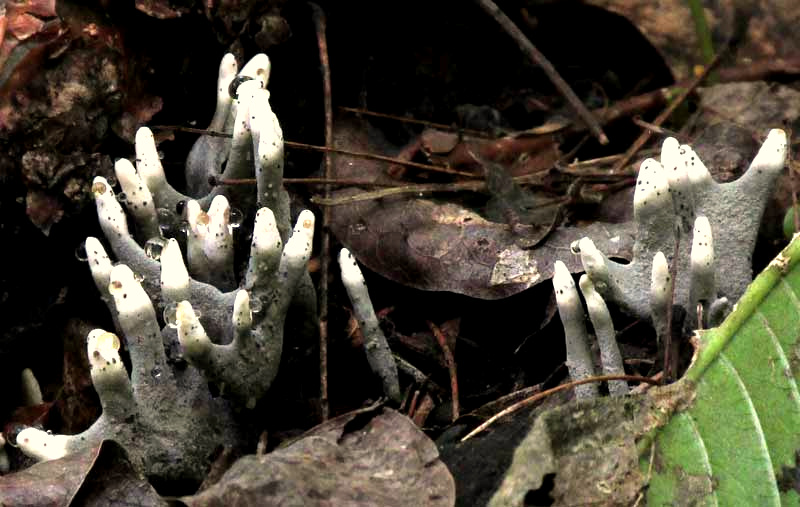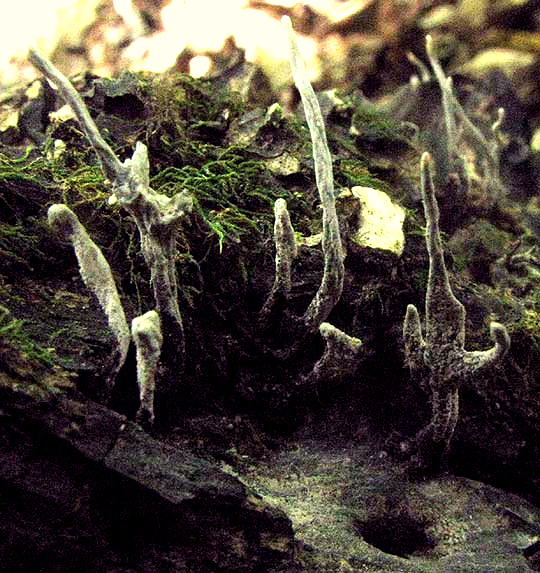Excerpts from Jim Conrad's
Naturalist Newsletter
from the July 3, 2016 Newsletter issued from Hacienda Chichen Resort beside Chichén Itzá Ruins, central Yucatán MÉXICO
CANDLESNUFF FUNGUS

Here the first two or three weeks of the rainy season are the best of the year for looking for mushrooms. Most of the year it's too dry for them, and later in the rainy season my impression is that fungi are more interested in sending white, rootlike strands (hyphae) through the soil, feeding on decaying organic, than producing reproductive bodies -- mushrooms.
Not all fungus reproductive bodies are standard mushrooms, however. There are puffballs, stinkhorns, jelly fungi, coral fungi, molds, mildews, and many more forms. This week in the Hacienda's deeply shaded, humid, jungly, rejollada-type sinkhole, ¾-inch tall (20mm) fungal bodies unlike any standard mushroom turned up, shown at the top of this page.
Notice that some are broad-based and branching while others consist of single, slender, finger-like bodies. Below, you can see another interesting feature:

In that super-humid environment, most of the bodies were topped with drops of clear liquid. I can't say whether they're dewdrops from the previous night, or whether the bodies are ejecting water from their interiors, the way many plants do, in the process known as guttation. In the above picture, atop the brown stem cutting diagonally across the picture's bottom, notice what appears to be a gray film consisting of something that seems to have issued from the fruiting bodies. More about this below.
Nearby, some of the same kinds of fruiting bodies were standing alone, so that their bases could be seen, as shown below:

We've seen this fungus before, up in a humid bayou bottom in Mississippi, though those fruiting bodies were older, drier, and more shriveled up, as seen in the next section.
Back then we identified this as Candlesnuff, XYLARIA HYPOXYLON, and passed on the observation that the name Xylaria hypoxylon often is treated as a catch-all for specimens that look more or less like what's in our photos, but might be something else, quite possibly something not known to science. Collectors just "dump them" in that name, waiting for a future expert to come along, make a monumental study of the group, and tell us all what all the various forms should be called.
So, that's what we're doing here -- dumping.
However, even with such an undignified approach, we can know certain things about our fungus. For example, it grows on or near decaying hardwood, so it's "saprobic." The fruiting bodies -- known more technically as ascocarps -- under certain conditions can grow over three inches tall (8cm) tall. When the ascocarps first emerge, as they are doing now, the powdery gray material seen above on the stem consists of clusterings of asexual spores call conidia. Later in the season the ascocarps will turn blackish and be minutely pimply. The tiny bumps will be structures called perithecia, and these are the sites where sexual spores are produced. Our Mississippi Candlesnuffs showed these pimply ascocarps.
A 2008 paper by Gu W and Ding H in Chinese Chemical Letters 19(11): 1323-26 reports that Xylaria hypoxylon contains compounds moderately effective for destroying cancer cells of the type Hepatocellular Carcinoma Cell Line Hep G2.
from the July 8, 2012 Newsletter issued from the woods of the Loess Hill Region a few miles east of Natchez, Mississippi, USA
CANDLESNUFF
A couple of Newsletters back we looked at the strange little fungus known as Candlesnuff, Xylaria carpophila, growing from a fallen Southern Magnolia fruiting body. Candlesnuff's page is at https://www.backyardnature.net/n/x/xylaria.htm.
This week we have a similar but less slender and more branching Xylaria species that lives on wood and is more commonly encountered. It's shown in its forested, ravine-bottom habitat, which in my picture unexpectedly turned out to look like a very lugubrious and foreboding place, below:
 .
.
This fungus, like our last one, sometimes also is known as the Candlesnuff Fungus, but also it's called Candlestick Fungus, Carbon Antlers, Stag's Horn Fungus and other names. The taxonomy of the genus Xylaria is poorly understood, but I'm labeling our find XYLARIA HYPOXYLON because of this: Michael Kuo at MushroomExpert.Com writes that "Even with identifiable specimens in hand, there is no getting around the fact that microscopic analysis is frequently necessary for accurate Xylaria identification -- which leads many collectors to label their collections of fat specimens 'Xylaria polymorpha' and their skinny collections 'Xylaria hypoxylon,' since these are species frequently included in field guides."
We've encountered the "fat" Xylaria in the Yucatan. You can see how fat it was at https://www.backyardnature.net/yucatan/earth-tg.htm.
Michael Kuo further writes that "The genus Xylaria consists of funky, club-like decomposers of wood or plant debris that become black and hard by maturity, reminiscent of carbon or charcoal."